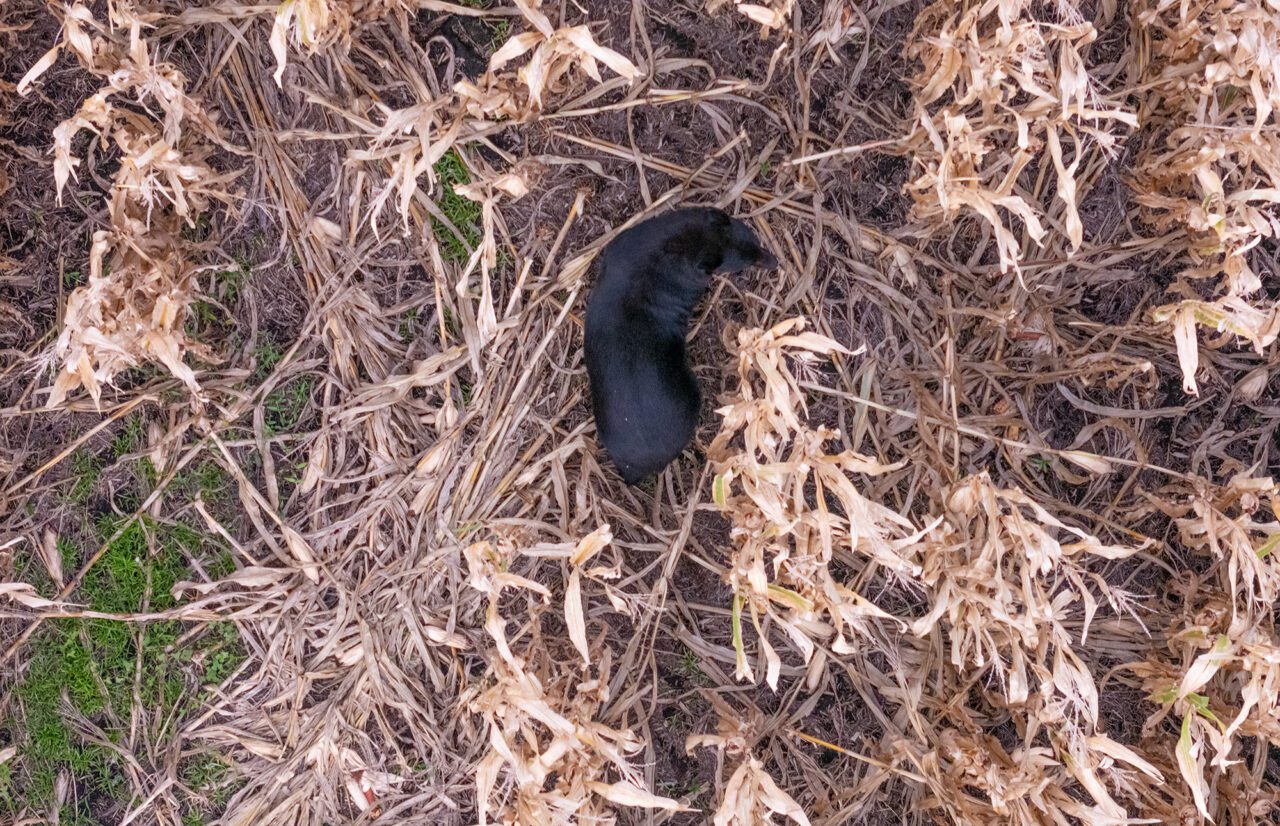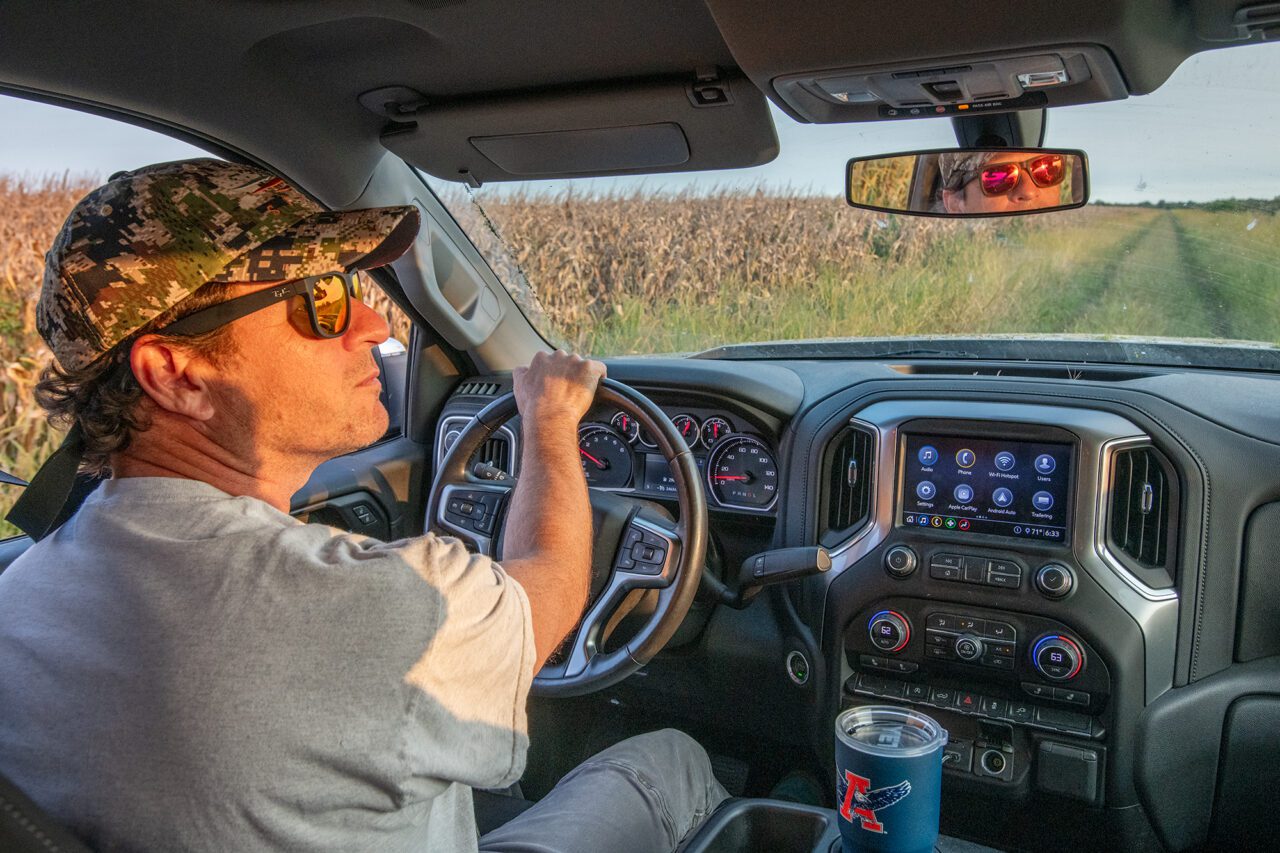
Second of two parts. Read Part 1.
By the time Chase Luker pointed the headlights of his king cab truck down a narrow country road that returned to Columbia, nighttime blanketed rural Tyrrell County.
Supporter Spotlight
A hunter safety specialist with the North Carolina Wildlife Resources Commission, Luker had spent his evening with Coastal Review meandering along farm tracks on private land, with permission, and the dirt lanes of the Pocosin Lakes National Wildlife Refuge, to catch a glimpse of American black bears.
As the unofficial tour of Tyrrell County came to a close, Luker said that he’d never met anyone who hates bears.
“Everybody loves bears, but the people that love them the most are the people that hunt them,” Luker said, adding the hunters “care a lot about the bears and what they can do to protect the species.”

Bears also seem to be a source of pride for Tyrrell County residents and businesses. During an early dinner at the Mexican grill downtown earlier that day, two locals shared photos of bear sightings.
A longtime hunter, Luker manages the 13-county District 1 that spans from Currituck to Carteret County and Greene County is the farthest county west. He also enjoys writing, carving decoys and, when he has time, guiding private hunting tours.
Supporter Spotlight
Luker noted that 150 years ago “we didn’t use canola oil, butter, we used bear fat, bear grease, rendered down.” He said there are numerous layers involved in what draws people to bear hunting. There’s a lot of legends surrounding black bears, and it’s “part of our American fabric.”

Black bear hunting heritage in North Carolina dates back to early Native Americans and was adopted by early colonial settlers, “Bear hunting continues to be an important tradition in North Carolina, bringing together friends and families, providing food for the table, and teaching outdoor and naturalist skills, the commission’s Game Mammals and Surveys Supervisor Colleen Olfenbuttel told Coastal Review recently.
She was the black bear and furbearer biologist, when she was responsible for managing and conserving black bears and 17 furbearer species, from 2007 until earlier this year, when she took on her current role.
“For decades, most bear hunters used the assistance of trained hounds to pick up the scent of a bear and track it,” Olfenbuttel continued. “In fact, the official state dog of North Carolina is the Plott hound, which was bred for hunting bears in North Carolina starting in the early 1800s.”

For a long time, the state’s black bear population suffered. “Black bears were once restricted to remote areas and reached very low population levels in the mid-1900s,” according to the agency. Hunters and conservationists pushed for bear hunting regulations beginning in the 1930s and for the state to establish a wildlife resources agency to manage wildlife and enforce wildlife laws.
Hunters joined in the conservation effort when the commission began managing the species in the 1970s, she said. The bear hunting community contributed by providing data needed to make science-based management decisions, and helped fund conservation and research efforts through hunting license sales and the Pittman-Robertson Act of 1937, which imposes an excise tax on firearms and ammunition.
Olfenbuttel added that “The restoration of black bears is also due to the reforestation that occurred, starting in the 1930s, and due to changes in human attitudes toward bears, as well as the remarkable adaptability of black bears. Black bears have adapted well to urbanization, human development and habitat fragmentation,” she said.
Public response
The North Carolina Bear Hunting Association, which formed in 1985, and past hunting clubs have worked with the agency over the decades, including on designating more thousands of acres of black bear sanctuaries, according to a March 2023 letter on its social media page.
In the letter, the organization notes that it has taken issue with how the agency has handled past investigations into illegal poaching, and the fact that the commission has online public hearing because “the anti-community has learned to take advantage of on-line public hearings and meetings.” The online meetings were in response to the COVID-19 pandemic.
During the 2021-22 session, those who are against bear hunting announced their support of a bill to “disapprove a rule of the Wildlife Resources Commission allowing hunting of bears in certain areas previously managed as bear sanctuaries.” The bill had a first reading but didn’t go anywhere after being referred to the house rules committee.
The bill was in response to the commission changing in February 2022 the title of “designated bear sanctuaries” to “bear management areas” and allow permitted bear hunting in three western lands previous off limits.
The commission made the choice to open up a permitted season to stabilize the growing bear population in the western part of the state.
Bear Defenders said on its its website that on Feb. 25, 2022, “Despite the overwhelming public opposition that included 2,744 comments, 86% percent in opposition, and our petition with over 7,600 signatures, the North Carolina Wildlife Resources Commission (NCWRC) voted unanimously to open up the Pisgah, Panthertown-Bonas Defeat, and Standing Indian Bear Sanctuaries to bear hunting and hunting with dogs. In addition, they approved a regulation that changed the term ‘designated bear sanctuary’ to “‘designated bear management area.'”
During a public comment hearing in January 2022, Olfenbuttel said that with a restored and increasing bear population coupled with a diverse and increasing human population and their associated development, “the Commission recognized the need to change from restoration efforts to management efforts to ensure the long-term viability of the bear population as well as assure and maybe even increase acceptance and support for the restored bear population to do so require developing a statewide Black Bear management plan.”

She added that the bear population had nearly doubled in size between 2005 and 2022, and one reason the commission has not been able to stabilize the bear population is that areas in the mountains where hunting is not permitted are increasing largely due to development.
In Defense of Animals said in a press release at the time that, “Despite public outcry, North Carolina has approved the violent killing of black bears in three of the state’s bear sanctuaries. With few exceptions, black bears have been protected throughout their natural habitats in North Carolina for decades. Thankfully, a new bill has been introduced to stop these shortsighted plans. We must urge North Carolina legislators to support House Bill 1072 to save vulnerable bear populations to agonizing deaths.”
Regulated bear hunting
With the state bear population recovered, Olfenbuttel said the commission’s objective is to stabilize the population so that growth is no more than 0-1%. “Basically, we want to maintain the number of bears we currently have on the landscape, with the bear population neither increasing or decreasing.”
She said that regulated bear hunting is an effective way to keep the bears healthy and reinforce a bear’s natural fear of humans, while allowing the animal to be used, particularly for its meat.
A survey of hunters shows that 99.6% use the bear meat they harvest, Olfenbuttel explained. Mostly they feed their household, share the meat or donate it.
“I estimated that the annual regulated bear hunting season provides over 610,000 plates of food for people, which is especially helpful for those North Carolinians that live in food deserts or who are on fixed incomes and have limited financial resources to purchase meat from a store,” she said. Adding that doesn’t account for other ways hunters use a harvested bear, such as rendering the fat, eating the organ meat, and using the bones to make bone broth.
She said that with the commission’s success in recovering the bear population, “we are seeing increased interest from all over North America, and beyond, to hunt bears in North Carolina, partly due to the number of black bears we have, but also due to the size of our bears.”
And bear hunting in eastern North Carolina has definitely grown in the last five or six years.
Luker has led guided hunting tours in the past. “There’s not much to do in Hyde and Tyrrell counties” and he stumbled across the opportunity. Though he enjoys guiding, he said the commission is his priority and “really believes in what the agency does.” In a quick exchange last week, he mentioned that he hasn’t had time to lead any tours this year.

While Luker drove during that recent evening through miles and miles of uninhabited, protected lands, he said that coastal North Carolina wasn’t even on the radar as a destination for black bear hunting until the last five or six years.
Some influential hunters were invited to the area, had a successful trip and put it on social media, and the industry has grown.
There are several outfitters that offer guided hunts on the coast, costing anywhere from $2,000 to $15,000 per person, and in some cases more. The amount depends on the company, length of hunt – usually from one to five days — and what is included in the package like lodging or meals.
Luker said the rates haven’t always been that way, just in the last four or five years, but seem to be leveling out. The guided hunts bring in what he called “high-net-worth” clients who “want to do something that they can’t do anywhere else in the world.” It’s becoming an economic driver.
“They contribute so much money to the local economy here,” he said.
License, e-stamp required
Luker reiterated that the hunter needs a big game license, which can be purchased through Wildlife Resources Commission, and a bear management electronic stamp, or e-stamp.
The license holder is only permitted to take one black bear a season. The bear must be more than 75 pounds and sows, or female bears, with cubs are off limits. The hunter must notify the commission of their take by calling 1-800-I-Got-One.
Bear hunting isn’t like deer hunting, though. “It’s not tricky,” he said. “Bears have a great nose, but they can’t see. Camouflage is not an important aspect of the hunt. You’ve got to wear blaze orange, and you have got to bring a firearm that’s capable of taking the animal clean.”
Luker said that for most hunts offered by an outfitter, the guide usually brings five to 10 hunters to approved land early and gets them ready to hunt by 30 minutes before dawn, when hunting is allowed to begin.
Some outfitters have a processing facility where they can weigh and dress the animal, though sometimes a hunter will remove internal organs on-site before moving the bear to make it lighter.
The hunt must be in a designated bear management area and the hunter must use approved methods only during bear hunting season, which is usually announced about nine months before it starts. Once the guides know the dates, the clients are contacted and told what to expect and what to bring.
“Generally, about every 10 years, our agency will do a bear management plan and make recommendations,” Luker said, but staff use data from year to year to establish the season.
Olfenbuttel is an author of the management plan, the most recent written while she was black bear and furbearer biologist from 2007 to 2024, and in the game and furbearer program.
She said the program works to ensure the long-term viability and sustained harvest of 71 game and furbearer species by providing the best possible scientific information on the status and management of each species and its habitats so that regulations and management are based on objective data and participate in planning and coordination of management directives based on sound science.
“For eastern North Carolina, that means monitoring the bear population using various metrics and surveys, such as harvest rates, age-at-harvest, sex ratio of harvest, number of vehicle-bear collisions, number of human-bear conflicts, as well as conducting bear research,” she said.
The commission is currently estimating the density and population of black bears across the 37 counties making up the Coastal Plain Bear Management Unit, which Olfenbuttel said is the first time the agency had conducted a study of this scale in eastern North Carolina for data to inform future bear management.
“The program uses all the data collected from multiple sources to monitor the status of the bear population and make informed, science-based management recommendations,” Olfenbuttel continued.
Because of regulated hunting, Olfenbuttel said the commission is meeting bear population objectives in eastern North Carolina, but as development increases, people and bears are living more closely together.
“Since bears can easily adapt to living near or in communities and neighborhoods, it will become increasingly common for people to see a bear in their neighborhoods and towns,” she continued. “This is normal, but people can do their part to live responsibly with bears by following the BearWise Basics, which mainly involves securing bird feeders, garbage, and not feeding or approaching bears.”
Note: Coastal Review will not publish Thursday and Friday this week in recognition of the Thanksgiving and Native American Heritage Day holidays, respectively.







